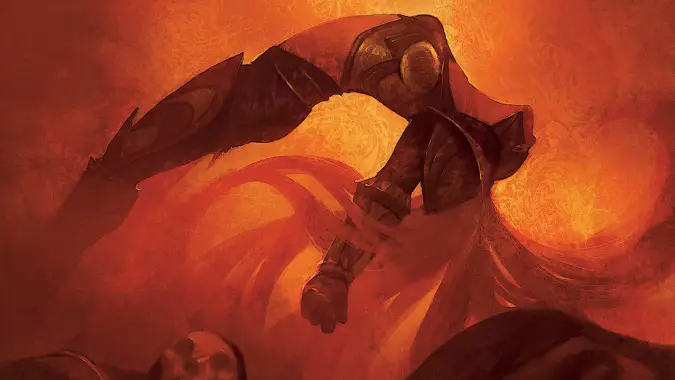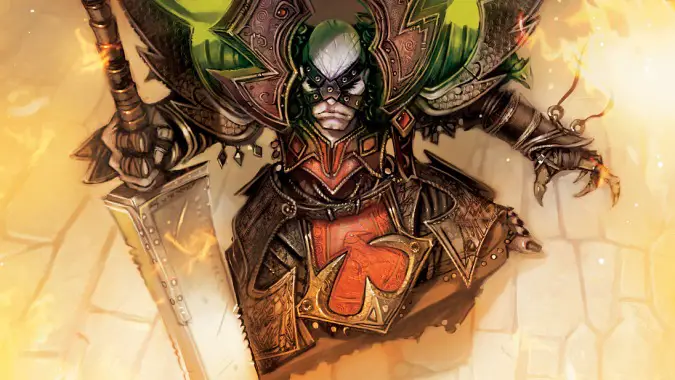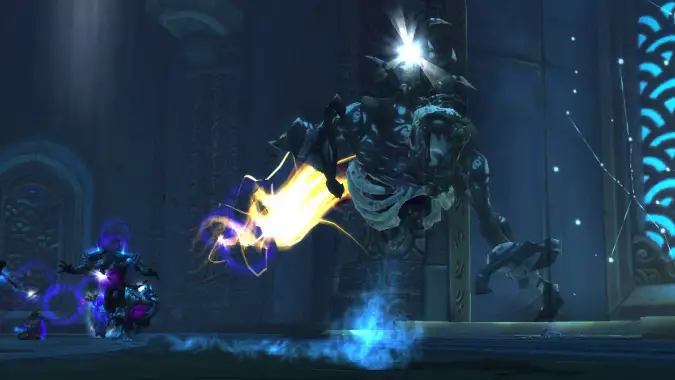Lightsworn: A darker side to Retribution

There are a lot of things in World of Warcraft that exist solely for game mechanic reasons: portals that traverse alternate universes, hearthstones, raid and dungeon finders, death knights. To Blizzard’s credit, most of these facets of the game are unobtrusive or cleverly blended into the game’s narrative and thus get a pass from the majority of the player base. One that has crept its way into my mind lately is an idea a bit more obscure than an out-of-place item or game system — Retribution’s ability to wield the Light in order to kill.
I’ll be the first person to admit that I’m not the most knowledgeable or enthusiastic lore-fiend out there. I wouldn’t say that I don’t care for lore; I did spend a lot of time reading Anne and Matt’s lore articles before I even started writing words alongside them. While that in no way makes me qualified to discuss the philosophical and religious tenets of Azerothian belief systems, I’d like to think my nearly seven years of playing Retribution grants me at least some creative freedom. Besides, as you’ll soon see all of this lore talk is really an excuse to change something that I believe is stagnating our spec: our dependence on Holy Power.

From what I understand, the basic philosophy of the Church of the Holy Light boils down to three ideas, aptly named “the Three Virtues” — respect, tenacity, and compassion. In northern Icecrown at the tournament grounds, Argent Confessor Paletress gives a short speech regarding the Three Virtues to an audience of Alliance and Horde champions. After chewing on her words for a short while, I find that the very purpose of the Retribution Paladin is at odds with one or more of these virtues. Both Protection and Holy, at a fundamental level, use the Light to preserve life, to heal and protect. Retribution, on the other hand, channels this energy to end life, to wound and defeat. What gives Retribution this license to kill? How can a Paladin, taught to respect life and be compassionate, select and eliminate such a wide variety of foes as we have faced throughout the years? Or if you’d like a really tough question, what happens when two Paladins meet in a battle to the death?
I’m certain our lore experts here at Blizzard Watch can give some insightful answers to many of these questions, but the point I want to address is the apparent contradiction of using a characteristically “good” force to commit ethically suspect deeds. When Holy Power first barged its way into our lives in Cataclysm, I didn’t give these ideas a second thought; I was busy trying to decide if I hated our new resource or not. But after three expansions of dealing with it, I think it’s due for a change. I mean, as it stands Holy Power is just a shinier version of a Rogue’s Combo Points, and we’re better than Rogues, right?
Introducing Depravity
In order to breathe some life back into Retribution’s rotation, we’re going to have to kill a lot of enemies. My idea for Depravity is a secondary resource to Holy Power that slowly builds as Holy Power is spent offensively — it would make sense to exclude Word of Glory from generating Depravity because healing and harming are two different ballgames. Harsh Words would be an interesting mechanic to deal with, but that’s putting the cart in front of the horse at this point.
When the resource reaches its maximum limit, it has to be dealt with or the Paladin will suffer. On the one hand you don’t want the Paladin to become Depraved right as the bar fills, because that’s more randomness that our spec doesn’t need, but you also don’t want to let players hold onto it to dish out unmanageable levels of burst damage without a downside. Therefore, at full Depravity the Paladin could either gain a debuff that increases damage taken or reduces healing received by a certain amount, or simply take periodic damage a la Burning Rush.

Relinquish
A cooldown called Relinquish then becomes usable when at maximum Depravity, wherein the Paladin purges his or her soul of this corruption by focusing inwards and releasing control of their body, allowing this pent-up darkness to burst forth and dissipate in one bloody, violent display. Knowing Blizzard, the spell effect would be something lame like turning your character red, but I digress.
Ideally, Relinquish would become our most powerful cooldown and work differently than Avenging Wrath to properly define the disparate elements of the new playstyle. In my opinion, I would like to see Relinquish buff secondary stats, namely Haste, in addition to Strength to highlight the dichotomy between the disciplined, elegant, and honorable Paladin and the ravenous, uncontrollable, and (dare I say it) savage creature constructed of guilt, despair, and rage.
To further this point, I’d posit that certain abilities, such as Word of Glory, Divine Shield, and Lay on Hands, be unusable when Relinquish is up. You can say that it’s because the Paladin’s connection to the Light becomes tenuous while he or she purges this presence, but really it’s meant to make using Relinquish a meaningful choice, a decision based on forgoing key defensive abilities in order to commit to dealing as much damage as possible.
Of course, all of this could be much too similar to what Blizzard has in store for the Demon Hunter, and I’d be left with my hands in my pockets, kicking at dirt. Regardless, the status quo of Holy Power as it applies to Retribution simply won’t do. With Inquisition removed, the intricacies of juggling Holy Power expenditures are gone and we’re left with an illusion of choice between single-target and AOE damage to spend our hard-earned golden points. With Legion on the horizon, now would be a perfect time to have our heroes cross some lines in order to defend Azeroth from the greatest threat it has ever known, and Depravity is aimed to do just that.
Please consider supporting our Patreon!
Join the Discussion
Blizzard Watch is a safe space for all readers. By leaving comments on this site you agree to follow our commenting and community guidelines.
 @Antigen_
@Antigen_



